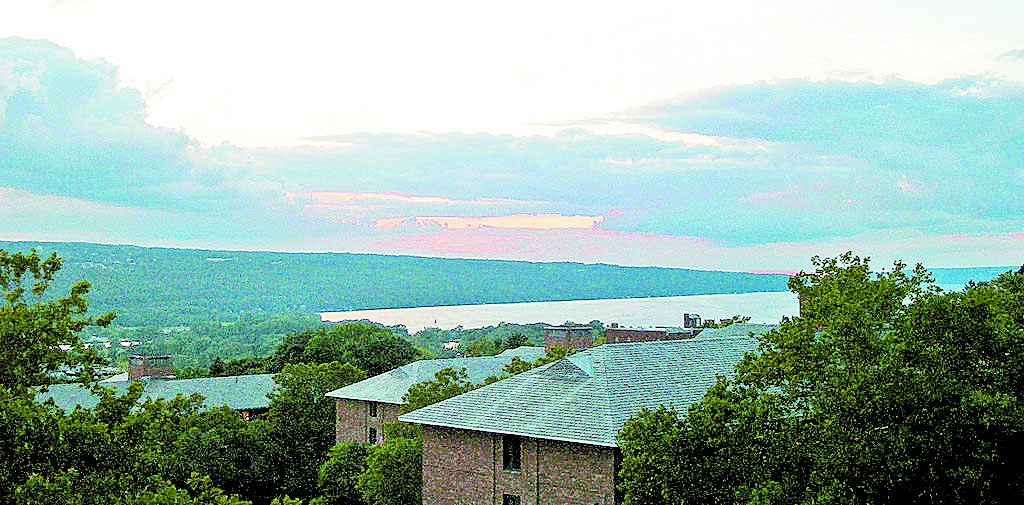By George Harvey
Here is a simple truth. There is no conceivable way we could give all the credit they deserve to the people working for a sustainable future in Tompkins County, New York.
Those who think this is an exaggeration should go to http://bit.ly/tompkins-county-accomplishments and take a look at what has been achieved in 2015 alone. Forty organizations have hundreds of achievements. One might only guess at the numbers of people involved.
Tompkins County may be most widely known for Ithaca, its only city. It is the home of Cornell University, Ithaca College, and Tompkins-Cortland Community College. The high levels of education in the county have been beneficial to its environmental movement.
One really interesting thing about gathering information from people of Tompkins County is the care they take to acknowledge the contributions of others. Among those who shine lights on the achievements of others is Jonathan P. Comstock, a Senior Research Specialist at Cornell University with a doctorate in horticulture. Aside from studying the effects of climate change on agricultural plants, he has been very active in Solarize Tompkins, serving as the board’s chairman.
Comstock had a lot to say about Solarize Tompkins, a non-profit organization. It began as a classic “solarize” movement. In time, it changed, but in a way that seems very positive. The program had been so successful that it had achieved double its original goal – but that raised a question. Was further education on solar power really necessary in Tompkins County, or would it be more effective to switch attention to something else?
“After two years of riding the solar rocket, we decided to take on home heating,” Comstock explained. In Tompkins County, heating produces about 75% of the carbon emissions associated with homes. So Solarize Tompkins started a new campaign, HeatSmart Tompkins, to organize energy audits, insulating, air sealing, help with evaluating options, and installation of heat pumps.
Another person deeply involved with sustainability in Tompkins County is Gay Nicholson. Gay has a doctorate in sustainable agriculture but spent most of her career working on land conservation, environmental ethics, and global warming. In 2004, she co-founded Sustainable Tompkins, which is the oldest sustainability organization in the area. Their programming has helped grow the local movement, and they are often the first to convene community conversations on climate and energy, greening the economy, and sustainable development. Their Finger Lakes Climate Fund collects carbon offset dollars to provide grants for energy efficiency improvements in lower-income households. So far, they have provided over $33,000 in 18 grants to help offset 1736 tons of carbon dioxide emissions.
Nicholson is also a member of the Tompkins County Planning Advisory Board and its Energy Road Map Steering Committee. In 2008, Tompkins County was the first to add an energy element to a county comprehensive plan in support of its goal of reducing fossil carbon emissions 80% by 2050. The Steering Committee then developed an energy roadmap for the county, a project that took several years, with students researching and writing on what mix of solar, microhydro, wind, geothermal, and biomass power, along with efficiency and demand management, would be needed to reach that goal.
Both Comstock and Nicholson referred to the Get Your Green Back Tompkins (GYGB). This campaign is community-initiated and community-supported. It helps people and organizations move toward sustainability for food, transportation, waste, and building energy, reducing carbon emissions, saving money, and creating a socially just economy.
GYGB has been helped by over a thousand volunteers and over a hundred businesses. Karim Beers, the campaign coordinator, said, “GYGB works by encouraging people to take 13 steps for reducing their carbon footprint, save energy, save money, and produce jobs. It encourages key behaviors that are good for the environment, focused on people who do not identify as environmentalists. This is about saving energy and money and connecting with ideas of conservation and being frugal. It is meant to be very inclusive reaching diverse populations.”
GYGB started a directory of stores selling second-hand goods and now works with over forty of them in Tompkins County. The director is available online at reusetompkins.com.
The Planning Coordinator for Tompkins County is Katie Borgella. She was the one who suggest the web site given in the second paragraph above.
The county Planning Department started working on energy issues about sixteen years ago, when a 147-kilowatt photovoltaic system was installed on the county library. Now, Borgella says, “Everybody feels a need to do as much as possible, as quickly as possible. Everyone is worried about tipping points, coral bleaching, and the fact that the jet stream has dipped below the equator for the first time.”
She conveys a sense of careful urgency, as she talks about protecting the green infrastructure at the upper reaches of watersheds. She says she finds it interesting to see how people are thinking and is heartened by the mind-set, pointing to the Energy Roadmap, which was wrapped up in March, and the fact that it says the county could get 80% of all its needs met locally.
A number of people mentioned Irene Weiser, a member of the town council for Caroline, New York. She has been very active working on banning fracking, pipelines carrying fracked gas, and our societies excessive use of fossil fuels. She started Fossil Fuel Free Tompkins with the hope that the county could be the first in the state to be so. The campaign is working on electric vehicles and charging stations. Weiser was mentioned more than once by other people commenting on her courage and devotion.
And the list goes on.









Leave a Reply